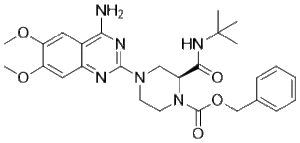L-765314 (L-765,314) is a novel, potent and selective α1b adrenergic receptor antagonist with Kis of 5.4 nM and 2.0 nM for rat and human α1b adrenergic receptor, respectively. It has mainly been used to investigate the role of α1B receptors in the regulation of blood pressure. The α₁-adrenoceptor family plays a critical role in regulating ocular perfusion by mediating responses to catecholamines. α₁-adrenoceptor-mediated vasoconstriction in murine retinal arterioles is buffered by the endothelium. When the endothelium is damaged, a vasoconstricting role of the α₁B-adrenoceptor subtype is unveiled. Hence, the α₁B-adrenoceptor may represent a target to selectively modulate retinal blood flow in ocular diseases associated with endothelial dysfunction.
Physicochemical Properties
| Molecular Formula | C27H34N6O5 | |
| Molecular Weight | 522.61 | |
| Exact Mass | 522.259 | |
| CAS # | 189349-50-6 | |
| Related CAS # |
|
|
| PubChem CID | 6603904 | |
| Appearance | White to off-white solid powder | |
| LogP | 3.946 | |
| Hydrogen Bond Donor Count | 2 | |
| Hydrogen Bond Acceptor Count | 9 | |
| Rotatable Bond Count | 8 | |
| Heavy Atom Count | 38 | |
| Complexity | 803 | |
| Defined Atom Stereocenter Count | 1 | |
| SMILES | CC(C)(C)NC(=O)[C@@H]1CN(CCN1C(=O)OCC2=CC=CC=C2)C3=NC4=CC(=C(C=C4C(=N3)N)OC)OC |
|
| InChi Key | CGWOIDCAGBKOQL-FQEVSTJZSA-N | |
| InChi Code | InChI=1S/C27H34N6O5/c1-27(2,3)31-24(34)20-15-32(11-12-33(20)26(35)38-16-17-9-7-6-8-10-17)25-29-19-14-22(37-5)21(36-4)13-18(19)23(28)30-25/h6-10,13-14,20H,11-12,15-16H2,1-5H3,(H,31,34)(H2,28,29,30)/t20-/m0/s1 | |
| Chemical Name |
|
|
| Synonyms |
|
|
| HS Tariff Code | 2934.99.9001 | |
| Storage |
Powder-20°C 3 years 4°C 2 years In solvent -80°C 6 months -20°C 1 month |
|
| Shipping Condition | Room temperature (This product is stable at ambient temperature for a few days during ordinary shipping and time spent in Customs) |
Biological Activity
| ln Vitro | Two earthquake sites are visible in L-765314. The high-affinity site, which corresponds to binding to the R1b site, accounts for about 25% of binding (IC50) 1.90 nM. 790 nM, or 75% of binding, is attributed to the low-affinity site and corresponds to binding to the R1a site [1]. |
| ln Vivo | The average Cmax of L-765314 (A322312) is 1.05 μM, and its t1/2 is 0.5 hours, according to curve display chromatography/mass spectrometry (LCMS) analysis results. The pressor response to A-61603 or deoxygen was demonstrated to be inhibited by L-765314. At a dose of roughly 0.3 mg/kg, L-765314 seems to be sensitive to the R1a receptor based on the pressor response of the inhibitor R1a isoform buffer A-61603. L-765314 and terazolin both tended to lower the gradient (about 25 bpm at 1 mg/kg i.v.) according to results on the antihypertensive effects [1]. |
| References |
[1]. 4-Amino-2-[4-[1-(benzyloxycarbonyl)-2(S)- [[(1,1-dimethylethyl)amino]carbonyl]-piperazinyl]-6, 7-dimethoxyquinazoline (L-765,314): a potent and selective alpha1b adrenergic receptor antagonist. J Med Chem. 1998 Apr 9;41(8):1205-8. [2]. The α1B-adrenoceptor subtype mediates adrenergic vasoconstriction in mouse retinal arterioles with damaged endothelium. Br J Pharmacol. 2014 Aug; 171(16): 3858–3867. |
Solubility Data
| Solubility (In Vitro) |
|
|||
| Solubility (In Vivo) |
Solubility in Formulation 1: ≥ 2.5 mg/mL (4.78 mM) (saturation unknown) in 10% DMSO + 40% PEG300 + 5% Tween80 + 45% Saline (add these co-solvents sequentially from left to right, and one by one), clear solution. For example, if 1 mL of working solution is to be prepared, you can add 100 μL of 25.0 mg/mL clear DMSO stock solution to 400 μL PEG300 and mix evenly; then add 50 μL Tween-80 to the above solution and mix evenly; then add 450 μL normal saline to adjust the volume to 1 mL. Preparation of saline: Dissolve 0.9 g of sodium chloride in 100 mL ddH₂ O to obtain a clear solution. Solubility in Formulation 2: ≥ 2.5 mg/mL (4.78 mM) (saturation unknown) in 10% DMSO + 90% (20% SBE-β-CD in Saline) (add these co-solvents sequentially from left to right, and one by one), clear solution. For example, if 1 mL of working solution is to be prepared, you can add 100 μL of 25.0 mg/mL clear DMSO stock solution to 900 μL of 20% SBE-β-CD physiological saline solution and mix evenly. Preparation of 20% SBE-β-CD in Saline (4°C,1 week): Dissolve 2 g SBE-β-CD in 10 mL saline to obtain a clear solution. Solubility in Formulation 3: ≥ 2.5 mg/mL (4.78 mM) (saturation unknown) in 10% DMSO + 90% Corn Oil (add these co-solvents sequentially from left to right, and one by one), clear solution. For example, if 1 mL of working solution is to be prepared, you can add 100 μL of 25.0 mg/mL clear DMSO stock solution to 900 μL of corn oil and mix evenly. (Please use freshly prepared in vivo formulations for optimal results.) |
| Preparing Stock Solutions | 1 mg | 5 mg | 10 mg | |
| 1 mM | 1.9135 mL | 9.5674 mL | 19.1347 mL | |
| 5 mM | 0.3827 mL | 1.9135 mL | 3.8269 mL | |
| 10 mM | 0.1913 mL | 0.9567 mL | 1.9135 mL |
